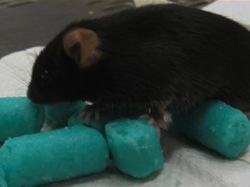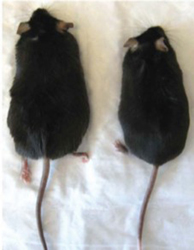High-Altitude Metabolism Lets Mice Stay Slim and Healthy on a High-Fat Diet
APRIL 5, 2001
Media Contact: Susan Brown (858) 246-0161
Comment: Randall Johnson

Mice with a disabled gene stay slim on a high-fat chow.
Photo: Na Zhang
Mice that are missing a protein involved in the response to low oxygen stay lean and healthy, even on a high-fat diet, a new study has found.
"They process fat differently," said Randall Johnson, professor of biology at the University of California, San Diego, who directed the research, which is published in the April 15 issue of the journal Cell Metabolism. While their normal littermates gain weight, develop fatty livers and become resistant to insulin on a high fat diet, just like overweight humans do, the mutant mice suffered none of these ill effects.
The protein, an enzyme called FIH, plays a key role in the physiological response to low levels of oxygen and could be a new target for drugs to help people who struggle with weight gain. "The enzyme is easily inhibited by drugs," Johnson said.
Because the protein influences a wide range of genes involved in development, the scientists were surprised that its deletion improved health.
"We expected them to die as embryos," said Na Zhang, a graduate student in Johnson's lab and lead author of the study. "Then we saw they can survive for a long time."

Mice like the one on the left in this photo gain weight and show signs of ill health on a high fat diet while their mutant littermates stay slender.
Credit: Johnson Lab, UCSD
"From the beginning I noticed that these mice are smaller, but not sick. These mice seem to be healthy," Zhang said. The lean mice have a high metabolism, and a common check for insulin resistance, a symptom of diabetes, revealed a super sensitivity to insulin.
"We fed the mice with a very high fat diet - 60 percent fat - just to see how they would respond," Zhang said. "Mutants can eat a lot, but they didn't gain a lot of weight. They are less fatty around their middles compared with their littermates."
Obese people develop a "fatty liver," and so did the wild type littermates. The fat mice also developed high blood cholesterol with elevated levels of the "bad" type, LDL. In lean mutants, LDL increased much less.
"All of these observations support that the modified mice have better metabolic profiles," Zhang said.
The genetic manipulations disabled the FIH gene entirely. "In every tissue, in every cell, the protein is gone," Zhang said. But the scientists wanted to know what part of the mouse physiology was responsible for the changes, so they created new mice in which the FIH protein was deleted only in specific tissues: the nervous system or the liver.
Mice that were missing FIH only from their nervous system showed most of the same effects. "But if it was only deleted in the liver, then no." Zhang said.
Though smaller, the mutant mice eat and drink 30 to 40 percent more than wild-type mice.
"Where do those calories go? To heat generation and an increased heart rate." Johnson said. They also breathe heavily compared with normal mice, taking in 20 to 40% more air. "This deep breathing is like exercise for them."
The FIH protein is part of a wide system that responds to low levels of oxygen. The mice behave as if they are breathing thin air. When people travel to higher altitudes, they breathe heavily for a few days, then adjust by producing more oxygen-carrying blood cells. "These mice never adjust to the apparent low oxygen," Johnson said. "They stay in this acute phase of hypoxic response their whole lives."
Co-authors include Zhenxing Fu, DeeAnn Visk, Gabriel Haddad and Frank Powell of the UC San Diego School of Medicine; Sarah Linke and Daniel Peet of the University of Adelaide, Australia; Johana Chicher of the Queensland Institute of Medical Research, Australia; and Lorenz Poellinger, of the Karolinska Institute.
Related Links